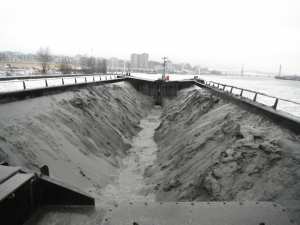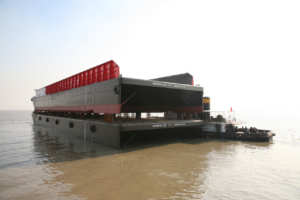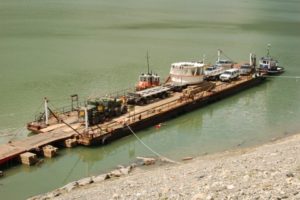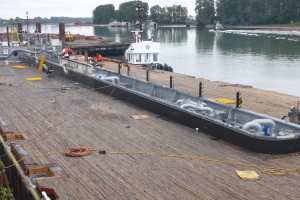Like us, barges come in all shapes and sizes and work at many different purposes.
They range from the simple punt to the very specialized heavy lift ocean going barges. In very general terms, a barge is a sealed vessel of very full form and a simple rectangular shape. Again, in very general terms, a barge has no machinery on board, being loaded and unloaded by shore-based equipment and front-end loaders. Finally barges can either be towed or be pushed.
Barge Types
The simplest vessels would be the flat-deck barges, or scows. These vessels are invariably rectangular in shape with scow bows and with a block coefficient well over .90. They are designed to carry a variety of cargo on deck from general supplies for isolated camps or communities, to giant blocks for offshore installations. The next step up in complexity would be the scows with box walls designed to carry bulk cargoes. A good example would be the numerous wood-chip barges which ply our west coast. A further development of the bulk barge with box walls is the larger sea-going vessel with a spoon or ship-shaped bow capable of extended ocean voyages. Yet a further development of this class of barge is the very specialized submersible barge capable of lifting oilrigs, dredges, and other awkward floating structures for long distance ocean transits. Barges also support cranes, pile drivers, and other construction equipment.
Oil and chemical barges are complex and are the exception in that they carry their cargoes below deck and they generally provide their own pumping system. As of this year, all oil barges are to be double-hulled which has led to a major new building program over the last ten (10) years. This midship section illustrates how the double hull is installed with the double bottom sloped to aid in drainage to a sump where the suction pipe is located. Probably the most numerous of all the barge types is the simple hopper barge designed to carry bulk cargoes in open hatches. These barges are definitely only for river or harbour work as due to their lack of longitudinal strength they would simply fold up in a seaway.
A most interesting variation on the hopper barge is the split hopper barge designed to transfer waste material, or spoil, out to a dumping ground. The two halves of the hull are hinged and held together via a pair of hydraulic rams.
The fundamentals of these barges types are:
- Long parallel mid body for maximum cargo lifting
- Simple repetitive structure
- Below deck void spaces sealed tight with no venting or internal piping.
As can be imagined, with all below deck compartments (or voids) sealed tight, it is rather difficult to sink a barge, but with all the cargo carried above the main deck it is more prone to capsize.
Barges can take an enormous amount of damage and still survive although this one has probably seen the last of her days. This large log barge broke free from its towing tug and was found draped across Edward King Island on the west coast of Vancouver Island. Her back was broken and her bottom plating ripped to shreds but after all this she did survive to sail again. The deck plate was cut to separate the bow and stern sections and compressed air was pumped into her void spaces giving enough lift for the salvage vessel with her traction winches to pull the sections into deep water. This unusual photo shows the two vessel halves being towed to Esquimalt Graving Dock for eventual repairs and reattachment.
This large deck barge capsized when a cargo of lime rock became water logged and subjected the barge to the Naval Architects nemesis of free surface effect. She rolled over onto the offloading dock doing much damage to her main deck and opening up 13 of her 21 compartments. As we saw on the last illustration, the barge is afloat on the air bubbles in her void spaces. To rotate this valuable barge while afloat, most of the voids were plumbed with 12-inch valves and one-and-a-half inch air spigots. These illustrations show the rotation with one side being flooded until the vessel is nearly standing on edge. A torqueing pull is then exerted at the extremities to rotate the vessel over centre at which time compressed air is applied to the previously flooded compartments to vent the water and to raise the barge upright.
Structure
Shown is a typical midship section of a heavy-deck bulk barges’ internal structure. We see the standard side and bottom webs transverses as well as the two longitudinal bulkheads and their webs. Virtually all barges are longitudinally framed due mainly to their long parallel mid body. This direction of framing greatly aids in maximizing the barges longitudinal strength. During the design period, very special attention is given to designing the main deck so as to give the vessel the maximum required deck strength.
The fore and aft rakes are designed to give a reasonable towing speed and sea-keeping ability within the constraint of maximizing the barges’ carrying capacity. Box walls are vertical structures that are tied into the deck edge of the main deck while allowing maximum cargo deck area while allowing reasonable walkways down each side.
Developments
As can be imagined, developments in barge designing come slowly, but there have been a number of them.
Barge Shape
The length to breadth ratio of four-to-one and a breadth to depth ratio of again four-to-one have been proven, over time, to give a good barge design and is a good place to begin with a new design.
Skegs
Skegs are appendages added within the aft rake to give the barge directional stability. Skegs have traditionally been either canted plates or banana-shaped appendages added to the aft rake to create drag (or parachute) effect. The latest designs now utilize side shell skegs, whereby the side shell plating is extended right to the stern, which has been found to give greatly improved directional stability coupled with reduced drag.
Bow and Stern Rake Radii.
A good number of years ago damage immediately aft of the forward and aft rake radii was noticed in older wood-chip barges. The damage was determined not to be corrosion but erosion caused by cavitation. This damage showed us that the existing radii on these barges were too tight. The latest designs on all sizes of barges with scow bows has been completed with increased radii both fore and aft eliminating separation and cavitation and giving a marginal increase in loaded towing speeds.
Deck Strength
The most convenient means for offloading a bulk barge is via a front-end loader running over the main deck to dig into the cargo. These loaders have grown greatly in size over the years, hence greatly increasing the force on the main deck. Wood sheathing, asphalt, and even concrete have been tried to strengthen the decks of existing barges but all have proven to be only stopgap measures.
New deck designs consist of heavy deck plate of 16, 19, or even 24mm in thickness combined with heavier longitudinals in the 170 x 125 x 12 mm range. It has been found that deck longitudinals fail under impact or excessive loading by tripping (illustration) which then allows the deck plating to dish giving, in time, the main deck to take up a starved dog look. An effective answer to this failure is to add carlins of 150 x 10mm flat-bar plating transversely at the half span of the longitudinal.
Slamming Areas
On scow-bowed barges, damage that was noted on older barges has now directed attention to the slamming areas forward, immediately aft of the forward rake. This damage can occur when towing empty barges in a seaway noting that coastal barges are rarely fitted with ballast tanks. Heavier bottom plating, coupled with intermediate transverse frames, satisfactorily strengthen these areas.
Side Shell Fendering
Traditionally, side shell fendering such as 10” x 10” wood strips, face-in angles or half pipe added longitudinally to the side shell have been applied to provide suitable fendering. Time has shown that these devices rot or crack and allow seawater to collect against the side shell plating inevitably leading to corrosion and eventually serious leaking. Newer barges have now eliminated these appendages and by increasing the side shell plating thickness over the wind and weather areas of side deck and shear strake, have effectively eliminated the need for fendering.
Finally, a most interesting development in barge design has been the progress in introduction of the Articulated Tug and Barge, or ATB, combinations into coastal and open water transportation . These combinations provide better control of the barges, both underway and when docking, as well as increased speed and somewhat better comfort for the tug crews.
We hope that you have found this overview of barge design of interest. Thank you.
Mark Mulligan, P.Eng.



